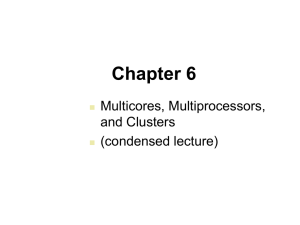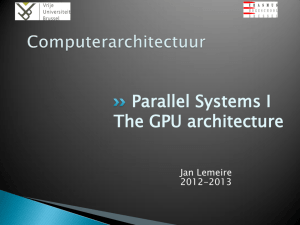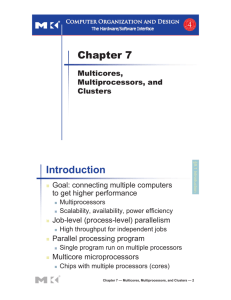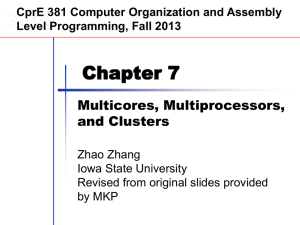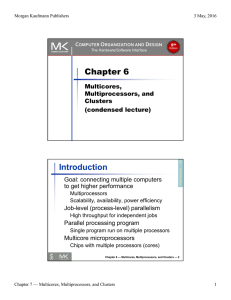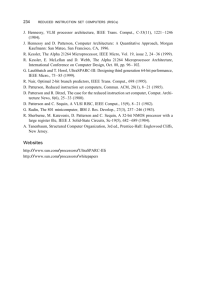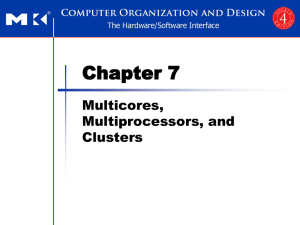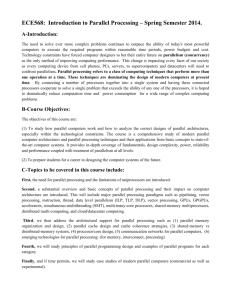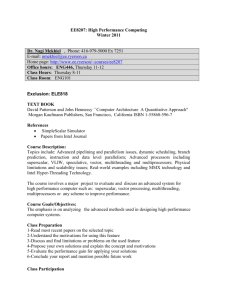Chapter 7
advertisement
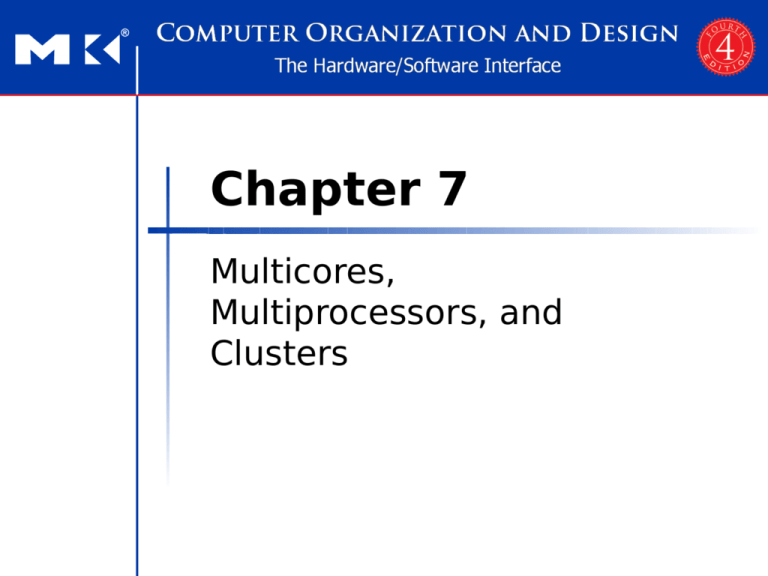
Chapter 7 Multicores, Multiprocessors, and Clusters ● ● Parallel software is the problem Need to get significant performance improvement ● Otherwise, just use a faster uniprocessor, since it’s easier! Difficulties Partitioning Coordination Communications overhead §7.2 The Difficulty of Creating Parallel Processing Programs Parallel Programming Chapter 7 — Multicores, Multiprocessors, and Clusters — 2 Strong vs Weak Scaling ● ● Strong scaling: problem size fixed Weak scaling: problem size proportional to number of processors Chapter 7 — Multicores, Multiprocessors, and Clusters — 3 ● SMP: Symmetric Multiprocessor Hardware provides single physical address space for all processors Synchronize shared variables using locks Memory access: UMA (uniform) vs. NUMA (nonuniform) §7.3 Shared Memory Multiprocessors Shared Memory Chapter 7 — Multicores, Multiprocessors, and Clusters — 4 Example: Sum Reduction ● Sum 100,000 numbers on 100 processor UMA ● Each processor has ID: 0 ≤ Pn ≤ 99 Partition 1000 numbers per processor Initial summation on each processor sum[Pn] = 0; for (i = 1000*Pn; i < 1000*(Pn+1); i = i + 1) sum[Pn] = sum[Pn] + A[i]; Now need to add these partial sums Reduction: divide and conquer Half the processors add pairs, then quarter, … Need to synchronize between reduction steps Chapter 7 — Multicores, Multiprocessors, and Clusters — 5 Example: Sum Reduction half = 100; repeat synch(); if (half%2 != 0 && Pn == 0) sum[0] = sum[0] + sum[half-1]; /* Conditional sum needed when half is odd; Processor0 gets missing element */ half = half/2; /* dividing line on who sums */ if (Pn < half) sum[Pn] = sum[Pn] + sum[Pn+half]; until (half == 1); Chapter 7 — Multicores, Multiprocessors, and Clusters — 6 ● ● Each processor has private physical address space Hardware sends/receives messages between processors §7.4 Clusters and Other Message-Passing Multiprocessors Message Passing Chapter 7 — Multicores, Multiprocessors, and Clusters — 7 Loosely Coupled Clusters ● Network of independent computers Each has private memory and OS Connected using I/O system ● Suitable for applications with independent tasks ● ● E.g., Ethernet/switch, Internet Web servers, databases, simulations, … High availability, scalable, affordable Problems Administration cost (prefer virtual machines) Low interconnect bandwidth c.f. processor/memory bandwidth on an SMP Chapter 7 — Multicores, Multiprocessors, and Clusters — 8 Sum Reduction (Again) ● ● Sum 100,000 on 100 processors First distribute 1000 numbers to each ● The do partial sums sum = 0; for (i = 0; i<1000; i = i + 1) sum = sum + AN[i]; Reduction Half the processors send, other half receive and add The quarter send, quarter receive and add, … Chapter 7 — Multicores, Multiprocessors, and Clusters — 9 Sum Reduction (Again) ● Given send() and receive() operations limit = 100; half = 100;/* 100 processors */ repeat half = (half+1)/2; /* send vs. receive dividing line */ if (Pn >= half && Pn < limit) send(Pn - half, sum); if (Pn < (limit/2)) sum = sum + receive(); limit = half; /* upper limit of senders */ until (half == 1); /* exit with final sum */ Send/receive also provide synchronization Assumes send/receive take similar time to addition Chapter 7 — Multicores, Multiprocessors, and Clusters — 10 ● Performing multiple threads of execution in parallel ● Fine-grain multithreading ● Replicate registers, PC, etc. Fast switching between threads §7.5 Hardware Multithreading Multithreading Switch threads after each cycle Interleave instruction execution If one thread stalls, others are executed Coarse-grain multithreading Only switch on long stall (e.g., L2-cache miss) Simplifies hardware, but doesn’t hide short stalls (eg, data hazards) Chapter 7 — Multicores, Multiprocessors, and Clusters — 11 Simultaneous Multithreading ● In multiple-issue dynamically scheduled processor ● Schedule instructions from multiple threads Instructions from independent threads execute when function units are available Within threads, dependencies handled by scheduling and register renaming Example: Intel Pentium-4 HT Two threads: duplicated registers, shared function units and caches Chapter 7 — Multicores, Multiprocessors, and Clusters — 12 Multithreading Example Chapter 7 — Multicores, Multiprocessors, and Clusters — 13 Future of Multithreading ● ● Will it survive? In what form? Power considerations ⇒ simplified microarchitectures ● Tolerating cache-miss latency ● Simpler forms of multithreading Thread switch may be most effective Multiple simple cores might share resources more effectively Chapter 7 — Multicores, Multiprocessors, and Clusters — 14 ● An alternate classification Data Streams Single Instruction Single Streams Multiple Multiple SISD: Intel Pentium 4 SIMD: SSE instructions of x86 MISD: No examples today MIMD: Intel Xeon e5345 §7.6 SISD, MIMD, SIMD, SPMD, and Vector Instruction and Data Streams Chapter 7 — Multicores, Multiprocessors, and Clusters — 15 SIMD ● Operate elementwise on vectors of data E.g., MMX and SSE instructions in x86 ● All processors execute the same instruction at the same time ● ● ● Multiple data elements in 128-bit wide registers Each with different data address, etc. Simplifies synchronization Reduced instruction control hardware Works best for highly data-parallel applications Chapter 7 — Multicores, Multiprocessors, and Clusters — 16 GPU Architectures ● Processing is highly data-parallel GPUs are highly multithreaded Use thread switching to hide memory latency ● Graphics memory is wide and high-bandwidth Trend toward general purpose GPUs ● Less reliance on multi-level caches Heterogeneous CPU/GPU systems CPU for sequential code, GPU for parallel code Programming languages/APIs DirectX, OpenGL C for Graphics (Cg), High Level Shader Language (HLSL) Compute Unified Device Architecture (CUDA) Chapter 7 — Multicores, Multiprocessors, and Clusters — 17 Example: NVIDIA Tesla Streaming multiprocessor 8 × Streaming processors Chapter 7 — Multicores, Multiprocessors, and Clusters — 18
